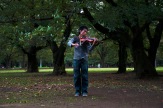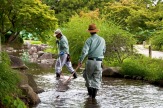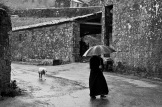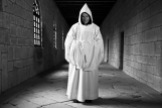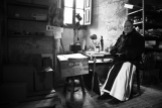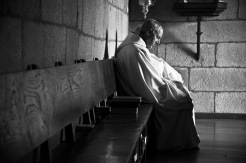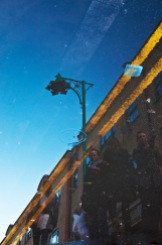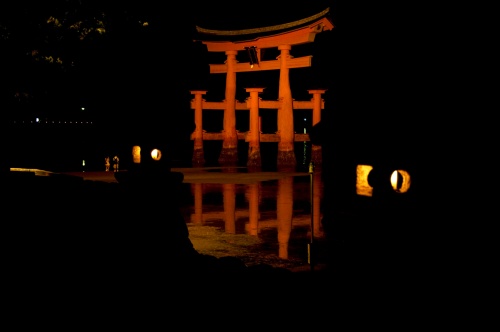Notepad
15/06/2014
Facing the Monsters

Monster by Sebastian Münster
You can click on any of the following images to check the whole gallery.
Critical Report
“Facing The Monsters” is a project born with the idea of exploring the theme of surveillance. During this project I tried to examine and analyse both conscious and unconscious ways in which I feel exposed, watched, tracked and spied living in a contemporary society of control armed with new weapons and mechanisms of surveillance.
This is a social issue we all have to deal with due to the fact we are living, for better or worse, in societies of control. No one can deny it. The surveillance state is our current society. There are a lot of questions in the air and we need to find answers and solutions. Everybody has different opinions about the new models of surveillance running in modern societies. For this reason I have decided to develop the project in first person instead of documenting different people perceptions. I wanted to face this matter and I have found the best way to do it is putting myself forward showing my own voice and thoughts about it.
My initial sources of inspiration come from some readings like ‘Postcript on the Societies of Control’ by Gilles Deleuze, ‘Evidence, Truth and Order: Photographic Records and the Growth of the State’ from ‘The Burden of Representation’ by John Tagg or ‘1984’ by George Orwell among many others. They were a great help to obtain a good knowledge about what Deleuze defined as disciplinary societies and societies of control and to understand how they behave. They were also crucial in order to bring and interesting idea and concept to life.
In terms of visual strategy I did some research looking through the work of other photographers and artists dealing with the topic of surveillance in one way or another. I first started with some photographers focusing their interest in modern weapons of surveillance and control. A good example is Google earth, a free satellite imagery service to the world that allows views of our planet to anyone with an Internet connection. Mishka Henner did several bodies of work like ‘Feedlots’, ‘Fifty-One US Military Outposts’, ‘Pumped’ or ‘Dutch Landscapes’ capturing images from the screen of his computer that have been previously photographed by these satellites orbiting the Earth. A similar approach have been followed for the photographer Michael Wolf in projects like ‘A series of unfortunate events’, ‘Paris’, ‘Eiffel tower’, ‘Manhattan’, ‘Fuck you’, ‘Portraits’ or ‘Interface’ where he developed his work taking pictures of the screen of his computer while observing virtually the world through Google street view. Later on I came across the installation „Col Tempo” The W. projectby Péter Forgács, media artists and filmmaker. This body of work is based on the banal motif of the human face and it examines the nature of the gaze with which one sizes up, recognises and comprehends another person. This idea of the human face made me think about the concept of the passport photo and the passport as other ways of surveillance and control. Finally I also have checked the work made by the Chinese artist Zhang Huan where we can see some self-portraits of his body half naked covered in words. This particular work is not linked with the surveillance theme but going through it was essential for me to develop the final visual idea of my project. Because from then on I knew exactly how I was going to use all these sources of inspiration and blend them together.
In this body of work I am showing a portrait of me half naked. I decided to use a portrait because it links with the idea of passport and passport photo, relevant as a method of control. And I am showing myself half naked as a metaphor of how I feel being tracked and controlled permanently in a surveillance society. Then inspired by Zhang Huan work, where he writes text on his naked body, I decided to apply multilayers in Photoshop to create a double exposure effect where I add a second image on top of my portrait. I have captured these images from the Internet or other sources in a similar way Michael Wolf, Mishka Henner or even Péter Forgács (all the faces exhibited in the showrooms come from the archive established between 1939-1943 in Vienna by the Austrian anthropologist dr. Josef Wastl for scientific purposes) did and they show several weapons or methods that surveillance society uses to control our lives.
Experimentation was crucial in the development of this project. I have been playing around with a lot of tools I was not familiar with. After five years shooting only on digital I went back to film, but this time using medium format cameras, something I have never done before. I wanted to try new things, explore new cameras and see what happens. On the other hand and in order to get the final images desired I also had to learn how to use multilayer techniques in Photoshop. The whole process was time consuming and I had to spend many hours learning new things and applying them into my photographic practice. But at the end of the day, it was worth the effort. Definitely I got what I was planning in my mind and the final pictures work successfully.
I have thought in this project as a body of work intended to be seen in a series of large prints in an exhibition or in book form. It also could be seen as a series of slideshows or as a multimedia piece on the Internet. I think we should go multiplatform to reach the largest audience possible.
But because I still believe in books as one of the best ways to show photography I decided to hand in my work in form of a book. Due to the characteristics of the book I had in mind I decided to build it by hand. The main reason of working in a handmade book was I wanted to do simple die cut holes in several pages, try different kind of papers and have more freedom to play around trying to be as creative as possible. Once again I made a risky move, because it was the first time I was making a book with my own hands. But I was enjoying this exercise and the idea of learning how to make my own books excited me. On top of that I had to learn how to use InDesign to work in the layout and design of my book. Developing this project was a complete challenge, but I have learnt a lot of new skills through the process.
After the feedback received in some tutorials about the idea and concept of the book I realized that I didn’t want my work to be just a selection of images displayed in a particular order. I wanted my book to be a combination of words and pictures. I strongly believe words and pictures work very well together. This combination is powerful, informative and even musical. We can detect certain rhythm in this mixture.
In order to add some text to each picture of the whole series of twenty-five images that constitutes the book, I had to do further research about the current societies of control, which are actually in the process of replacing those almost obsolete but still present disciplinary societies which, as stated by Deleuze in ‘Postcript on the Societies of Control’, follow a model of environments of enclosure where the individual never ceases moving from one space of enclosure to another. These closed environments have their own laws and they are the family, the school, the factory, the hospital, the prison…
Among the new weapons of surveillance of societies of control we could mention the pharmaceutical productions, genetic manipulations, molecular engineering, dataveillance, the development of locating, tracking and tagging technologies, face recognition, social surveillance or the use of social network sites like Facebook or Twitter, computer viruses, corporation… and many others that I have analysed through this piece of work.
The goal of these words is not to explain each picture. They are just some theories or quotes that link with the concept behind each image. They give some information extra helping the viewer to put the photographs into a particular context.
I got this information from supplementary readings like: ‘Naissance de la medicine sociale’ or ‘Discipline & Punish: The birth of the Prison’ (cited in Gougelet, D.O., ‘The World is One Great Hospital’) by Michel Foucault; ‘Webcams, TV Shows and Mobile phones: Empowering Exhibitionism’ by Hille Koskela; ‘Computer viruses, Artificial Life and Evolution’ by Mark A. Ludwig; ‘Imagining Surveillance: Utopian Visions and Surveillance Studies’ by Peter Marks; ‘The Public Domain: Social Surveillance in Everyday Life’ by Alice E. Marwick; ‘The Politics of Life Itself: Biomedicine, Power and Subjectivity in the Twenty-First Century’ ( cited in Styhre, A., ‘The Production of Informational Objects in Innovation Work: Pharmaceutical Reason and the Individuation of Illnesses’) by N.S. Rose; ‘Time, Work, Discipline and Industrial Capitalism’(cited in Scott, J., ‘Power: Critical concepts in Sociology’)by Thompson, E.P. and many more. At the end of the book I also decided to add a list of references where all the sources consulted are cited.
13/05/2014
Japan Daily Life
This gallery shows a selection of images of daily life in Japan. All pictures have been taken when I was backpacking the country on summer 2013. Click on any of them to get access to the slideshow.
25/03/2014
Oseira Monastery, A Life Of Prayer
As part of this assignment I have worked on a photo story documenting the life of the Cistercians monks at Oseira Monastery in Galicia, Spain.
Finally I decided to present this story as a multimedia piece under the title “Oseira Monastery, A Life Of Prayer”. Anyone can watch the film by doing a click on the image above or on the next link:
Oseira Monastery, A Life Of Prayer
Critical Report
This project has born with the idea of documenting the life of the Cistercians monks at the Monastery of Oseira in Galicia, Spain. I manage to get access to this community and the main goal was to portray their daily life inside the monastery and trying to find the mystery of a life dedicated to prayer. From an anthropological point of view I think this community of Cistercians monks is quite interesting in the sense they have a particular lifestyle. The spiritual purpose of the community is manifested especially in the liturgical celebration. They spend much of the day in prayers to fulfill the priestly function of Christ, offering to God a sacrifice of praise and interceding for the salvation of everyone. In the other hand the monastic life is a life of work, because it should be a life of poor. They have to work for a living. These monks make poverty an essential element in their lives. And the consequence of this poverty is the need to work. The monastic work is the element that contributes the most to the balance of Cistercian life.
In the Oseira monastery due to the big dimensions of the building each of the monks has a clearly defined occupation. But this is not the only occupation they have because they also carry the maintenance and upkeep of the building, the laundry, the garden, the library, the liquor production, the bakery, the hives, the inn, the shop…
I decided to work in a theme involving religion and its rituals because I find very strong some of the imagery taken by the Spanish photographer and member of Magnum Cristina García Rodero in her series “España Oculta”. The photographs in this series where taken during a journey she did for different towns in different regions of Spain between 1975 and 1988. They capture humans, their beliefs, festivals and activities in a popular and traditional framework. This series of images reflects the ritual elements of the party and, at the same time, shows the pure expression of the religious faith and also the role of the bulls in the various Spanish regional celebrations.
In this project I knew from the beginning that I would work following a classic structure of a traditional photo essay. But once in the monastery while I was following the monks in their daily routine I realized how present chants and prayers were in their lives. Was then when I decided that I didn’t want to sacrifice all this audible information. So, I started to record the prayers and any other sounds I though it could be useful to enhance the story. It was the first time that I was recording audio and I was not very familiar with the wave/mp3 recorder but I need to say that I enjoyed the process and I have learnt a lot during that time.
I had been taking photos and recording audio and, at the end of the day, I had to blend them together. For this reason I decided to present the final body of work as a multimedia piece where I could mix everything I got during my stay at the monastery. My initial idea was to work in black and white. By then I was planning to present the work as a series of photos with captions. But finally I decided to work on a multimedia piece and now I wasn’t too sure if I would keep the idea of working in black & white. I had some doubts. So, I started doing some research. I watched some multimedia bodies of work in black & white like “Brooklyn Gang” with photos by Bruce Davidson, “Between Heaven And Earth” with photos by Cristina García Rodero, “Children Of The Lotus” with photos by Abbas, “Capitolio” with photos by Christopher Anderson, “Picnic With Sergey” with photos by Bruce Gilden, “The Shipping Forecast” with photos by Mark Power, “Access to Life: Rwanda” with photos by Gilles Peress or “Requiem in Samba” by Alex Majoli. I found really interesting the aesthetic and the strength of these short black and white movies. Definitely I decided to carry on with my initial idea and present my project as a black and white multimedia piece.
The next gallery shows a selection of the pictures taken. Please click on any of them to check the whole gallery and captions.

22/10/2013
Japan Travel Internship 2013
I have received a photojournalism internship with the popular tourism guide Japan Travel. For a couple of months (October & November 2013) I will be working on photo stories covering mainly the areas of Tokyo, Saga, Nagasaki, Kagoshima and Okinawa. Anyone interested in following my adventures in Japan can do so here.
17/12/2012
2 meters
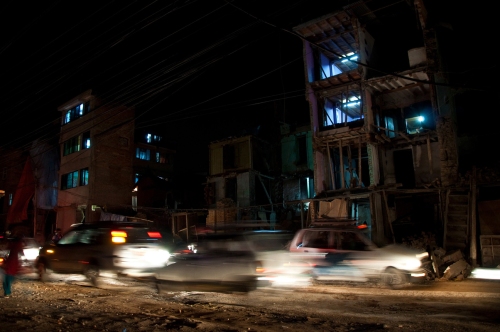
Images from my last personal project about the side effects of the Road Expansion Project in Kathmandu city (Nepal).
The ambitious dream of a modern city with wider roads is turning into a nightmare for innumerable families. Most of them, not receiving any compensation from the government, are forced to demolish their homes with their own hands in benefit of the “2” meters wider new road and to pay for the costs of the new buildings. In the meantime they live in unsafe ruined houses or, if they can afford it, renting another place. With this story I just want to give some voice to the voiceless.
You can check the whole series of images doing a click on the image above or alternatively on the next link:
http://senengermade.com/2-meters




















































